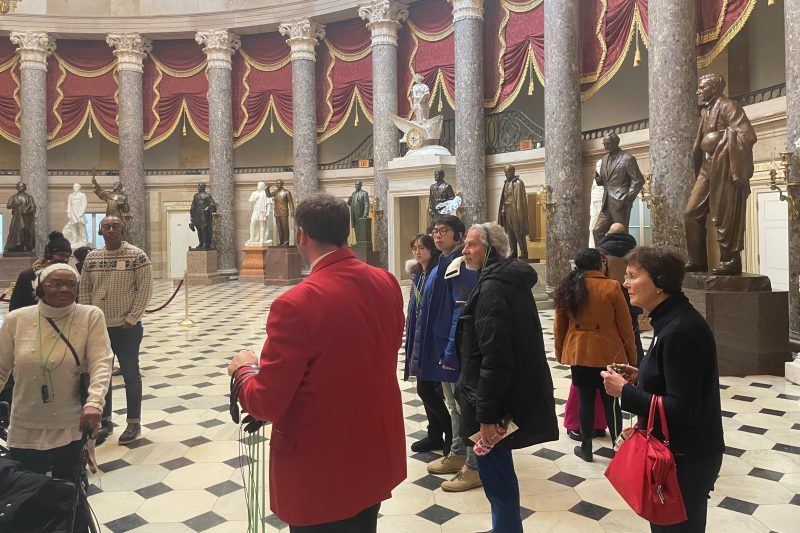Visitors on official guided tours of the U.S. Capitol are peppered with facts about its rich history. They learn about the building’s architect and the materials used to construct it. They are told how the British army torched the Capitol in 1814. And they are reminded that Abraham Lincoln vowed to finish its construction during the Civil War to show the Union would go on.
But unless visitors ask, they probably won’t hear a word from the red coat-wearing guides about the Jan. 6, 2021, attack by supporters of former president Donald Trump who were seeking to stop the certification of Joe Biden’s electoral win.
The attack is not mentioned in the Capitol Visitor Center’s newly renovated exhibition hall, which provides a robust history of the building. Nor is it discussed in the seven-minute introductory film that visitors watch before the tour commences. And as the second anniversary of the attack approaches, the visitor center has not announced any plans to address it.
It is not by accident that the guides are silent about one of the building’s darkest and most consequential days, even as highly publicized hearings about what happened unfolded under the same roof. They have been told to only refer to Jan. 6 if questioned on a tour, according to former tour guides and people familiar with the center’s operations. It is a policy that in many ways reflects a country at odds with itself, unable to agree on fact and truth and reluctant to engage on the history of a day that threatened democracy.
Officials at the Capitol Visitor Center, which operates the tours, declined to comment on what guides are told they can say on tours. The policy of not commenting, they said, “is in keeping with our history of deferring to congressional authorities on most issues.” The House Administration Committee and the Senate Rules and Administration Committee oversee the center.
The center also said it could not share how many visitors go on the official tours each year or how many tour guides work at the Capitol, which reopened to tourists last spring after a lengthy shutdown because of the coronavirus pandemic.
But a visitor center official, speaking on the condition of anonymity to be candid, confirmed that tour guides are told to avoid bringing up Jan. 6, current events and any legislation under consideration by Congress.
To some, the silence is unacceptable.
“A reminder is critical,” said Rep. Madeleine Dean (D-Pa.), who was in the Capitol when it was overrun and later served as an impeachment manager for Trump’s second impeachment.
“I hope that the administration of the Capitol recognizes that it is a critical moment in our nation’s history, and it has to be not politically remembered, but historically remembered,” Dean said in an interview. “It was an attempted overthrow of our government by Americans incited by a president. And at some point, we will get comfortable saying that.”
Dean also said she believes some of the damage to the Capitol should have been left intact as a reminder of the violence of that day and the attempt by those who forced their way into the building to halt the democratic process. Windows and doors were shattered, paint was tracked on stairwells and on statues, and fire extinguishers and chemical sprays left a residue that took weeks to clean up.
Others say it is understandable that guides are instructed to not bring up Jan. 6.
Gregg Harper, a former Republican congressman from Mississippi who was chairman of the House Administration Committee from 2017 to 2019, said that it is necessary for guides to avoid controversial topics and that it would be difficult to craft language or exhibits on Jan. 6 that wouldn’t be divisive.
“Who’s going to write the [Jan. 6] narrative, and how are you going to do that in a way that’s not politicized?” Harper said in an interview last month. “I think that it’s appropriate to say, ‘Hey, don’t discuss current events,’ but if a guide gets asked a specific question or a question about anything, most guides, I’ve found, will try their best to answer that question.”
Harper was in the Capitol on Jan. 6 as a visitor observing the electoral count, and the attack still makes his “blood boil,” he said. Still, he is optimistic that “we will never have anything like that occur again.”
But avoiding Jan. 6 on tours doesn’t sit well with Rep. Jamie B. Raskin (D-Md.) a member of the House select committee investigating the Jan. 6 attack that recently released its detailed report on the events surrounding the day.
“The idea of censoring it or hiding it just makes no sense to me,” Raskin said in an interview last week. “I would link this impulse to quickly cover everything in a blanket to these memory laws that are breaking out around the country, stifling the teaching of the Civil War or Jim Crow or discrimination against gay people. It’s kind of like, ‘Don’t say Jan. 6,’ and that suppression of memory is the very opposite of neutral and objective.”
A number of former Capitol tour guides interviewed for this article say they understand why not discussing Jan. 6 would make sense.
“So many visitors are going to be on both sides, for lack of a better term,” said Peter Byrd, a retired former guide who led more than 13,000 tours.
Indeed, some prominent Republicans, including Trump and current members of Congress, have rejected classifying the attack as an insurrection. Instead, they have downplayed the actions taken by those who stormed the Capitol, attacked police officers, rifled through desks on the Senate floor, occupied the offices of House Speaker Nancy Pelosi (D-Calif.) and called for Vice President Mike Pence to be hanged rather than allow him to certify Biden’s victory.
Byrd, who was horrified by the events as he watched them unfold on television, said he would be extremely careful talking about it during a tour and would avoid any inflammatory language.
“Anybody who’s been around the Capitol any length of time knows that if you’re not real careful in your choice of words, sometimes you can end up in a hornet’s nest,” he said. “For that reason, I wouldn’t use the word ‘insurrection,’ even though that’s word I call it when I’m talking to friends about it.”
Maybe the only way to address it now, he said, is to say: “Yeah, it happened, and yeah, it was a mess.”
Erik Jensen visited the Capitol a few days before Christmas with his wife, Mary. The Pleasant Grove, Utah, couple, who were on their first trip to Washington, said a visitor in their tour group raised the Jan. 6 attacks with the guide. “It was a little awkward,” Erik Jensen said as he stood outside the Capitol. “They tried to skirt around it. I assume that will all change over time, but it’s a little too fresh right now.”
Having the guides present the facts about Jan. 6 is “a real dilemma for the civil servants trying to do their job,” said James Grossman, executive director of the American Historical Association, the country’s oldest professional association of historians. “No matter what they say about Jan. 6, they are going to get in trouble because people will disagree with them. One casualty of this polarization we’re facing is our inability as communities and individuals to accept straightforward facts based on clear evidence.”
“If we cannot agree on basic facts,” Grossman added, “we cannot constructively discuss any aspect of our history or what we learn from it.”
Liam Gideon owns Guided Tours DC and accompanies his groups on the official tours of the Capitol eight to 10 times a week. Invariably, he says, someone in almost every group will ask about Jan. 6, and the answer from the guides is almost always the same.
“The response is, ‘We’re not allowed to answer any questions about that,’” he said.
Gideon understands the questions could put the guides in a difficult spot, but he says many visitors only know the Capitol from videos of that day and they have questions that can be answered candidly. He will often address questions from tourists in his groups after they leave the Capitol.
“Most people are curious,” he said. “Some of them won’t be happy with what you are saying. But we base everything we say about Jan. 6 off of historical facts. It makes it hard for people to get irritated by that or push back when you’re sticking to the actual facts.”
Raskin worries that avoiding the subject now will only cause more problems later.
“I think what might seem to be a necessary form of etiquette today in order not to inflame things among tourists, you know, very quickly becomes a kind of Orwellian memory hole,” said Raskin, who has proposed Capitol tours specifically related to Jan. 6. “I just think it’s a lot safer to state as factually and forthrightly as possible where different things happened and how they transpired.”
Since Jan. 6, approximately 930 people have been arrested and about 508 convicted for their roles in the attack, according to the Justice Department. U.S. prosecutors have estimated that the siege resulted in about $2.9 million in losses, including building damage and Capitol Police costs. The FBI continues to search for approximately 350 people who are believed to have committed violent acts, including attacks on police officers, on Capitol grounds.
Aquilino Gonell, one of about 140 Capitol and D.C. officers injured on Jan. 6., wants visitors on tours to see the doors of the Lower West Terrace, where he and his Capitol Police colleagues held the line against the mob that day. Gonell served as an officer on the force for 17 years before announcing his departure last month, citing physical and mental injuries he suffered on Jan. 6.
Police were bludgeoned with poles and bats, pushed and trampled, and sprayed with chemical irritants. A Capitol officer, Brian D. Sicknick, collapsed after confronting rioters and died a day later of a stroke. Two other officers in the riot, one Capitol, one D.C., later died by suicide.
“What we endured was medieval, brutal, for close to four hours,” Gonell said in an interview last week. “Our efforts were heroic despite the injuries and the odds.”
In a letter he posted on Twitter announcing he was leaving the force, Gonell, an Army veteran who served in Iraq, said a 1996 high school trip to Washington “wound up piquing my interest to serve the nation by becoming a public servant after visiting the majesty of the United States Capitol.”
Now when he visits the Capitol, he can’t shake the darkness of the day it was attacked. Tourists, he said, need to be told that story, too.
Paul Kane, Spencer S. Hsu and Peter Hermann contributed to this report.



























